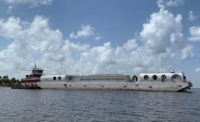After decades of false starts, one of architect Louis Kahn’s final works, a 4.5-acre park in New York City to honor President Franklin D. Roosevelt, is scheduled to break ground in mid-August on the synergistically named Roosevelt Island, in the East River.
Today, the nine-member board of the Roosevelt Island Operating Corporation voted 7 to 1 in favor of the proposal.
Today, the nine-member board of the Roosevelt Island Operating Corporation (RIOC), which is the public authority that runs the island, voted 7 to 1 in favor of the proposal, with one member not present.
The $45 million project, to be called Four Freedoms Park, after a well-known Roosevelt speech, has secured the entire $14.7 million in public and private money it needs for the first phase of construction, says Gina Pollara, who is supervising the project on behalf of the Franklin and Eleanor Roosevelt Institute (FERI), the sponsor.
Plus, the park, which will be located on the island’s southern tip, across from the United Nations, has secured two-dozen necessary approvals from 18 city, state and federal agencies. “I’m thrilled,” says Pollara, who trained as an architect. “We’re definitely moving forward.”
The park’s dart-shaped design, which Kahn created in 1974, features stone-paved promenades that edge a sloping lawn, which is fringed with allees of linden trees. At the tip will sit a 3,600-square-foot enclosure ringed with 28 tall granite blocks inscribed with snippets of the “Four Freedoms” speech, which Roosevelt gave to Congress in 1941 extolling the freedoms of speech and religion, and from want and fear.
Though some steps in the enclosure will give way to wheelchair-friendly ramps, to bring the park up to snuff with modern codes, the end result would be remarkably similar to Kahn’s original, says Paul Broches, AIA, a principal at Mitchell/Giurgola Architects, the lead architect.
“We wanted to retain as literally as possible everything in that design,” says Broches, who drafted the original construction documents in 1975. (The project was scuttled in the 1970s due to funding woes; a revival of the scheme in the 1990s encountered political resistance.)
The first phase entails construction of the enclosure at the tip, and the adjoining sculpture court. Phases two and three, which still await funding, call for work on the east and west sides of the park, landscaping, and construction of the large granite sections, according to Pollara.
When the park is completed, it will earn a pair of firsts. It would be Kahn’s premier project in New York City, in a state with just two of them: Temple Beth El, in Chappaqua, and First Unitarian Church, in Rochester.
It will also be the first Roosevelt memorial in the president’s native New York State, which would please Kahn, who designed housing projects in Philadelphia during the Depression through Roosevelt-created jobs programs, says Sue Ann Kahn, his daughter.
“My father was supported by the W.P.A.,” Kahn says. “I remember listening to reports of Roosevelt’s death on the radio during dinner.”
However historic, the design has opponents on Roosevelt Island, which is home to about 12,000 people, for its use of $8.5 million in public funds. Others have argued that the park’s trees would block front-and-center views of the United Nations’s Secretariat building. Indeed, in a local online survey conducted in April, 29 respondents said they didn’t like Kahn’s design, as compared with 22 who did, with 15 undecided.
Other complaints came from the Roosevelt Island Disabled Association, an 80-member, 24-year-old group that represents the island’s sizeable handicapped population. It wanted FERI to add a likeness of Roosevelt in a wheelchair, in addition to the bronze head currently slated to be there, to help foster a role model for disabled children, says Jim Bates, the groups’ treasurer.
“Roosevelt’s disability gave him a better understanding of freedom,” Bates says. “His wheelchair gave him freedom of movement.”




Post a comment to this article
Report Abusive Comment